The year is 2003.
The ‘Tricky’ in my painting below is a little filly that I had a special bond with… She is no ordinary horse. she is a wild ‘Konik’ horse, that was born in The Netherlands. I saved her life. This is her story.
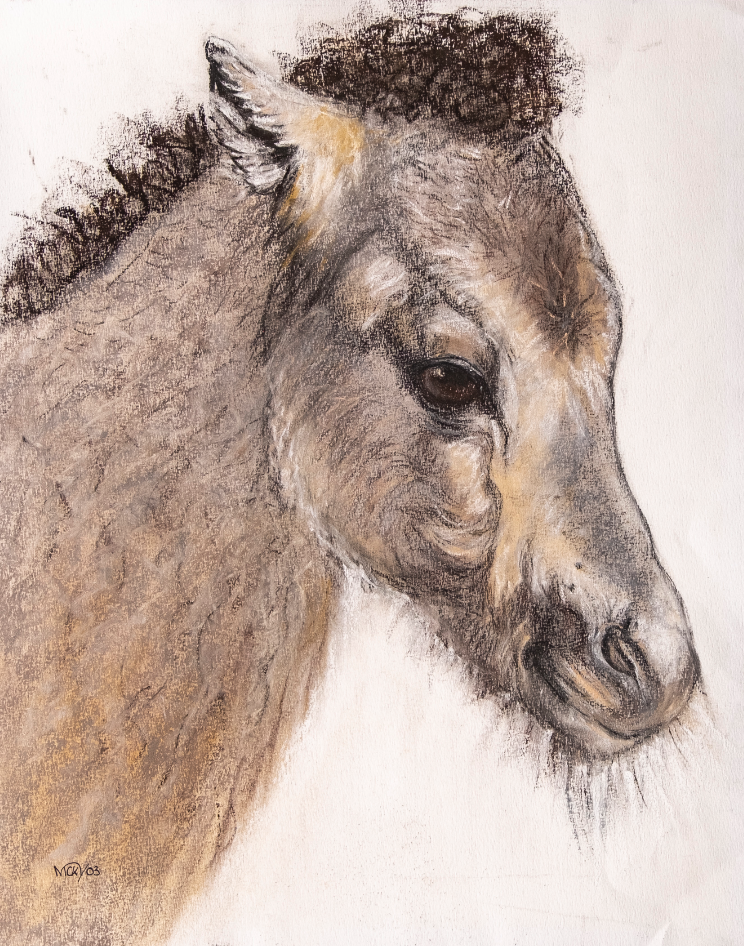
Koniks are small, semi-feral horses from Poland. They show many primitive markings, including a dun coat and dorsal and leg stripes. This made scientists all over the world suspect that they were closely related to Eastern Europe’s original wild horse, the long extinct ‘Tarpan’. Whether this is true or not, it is a fact that the Koniks are one of the few horse-‘breeds’ that are only minimally meddled with by humans. And this results in them showing us what original horse behavior looks like.
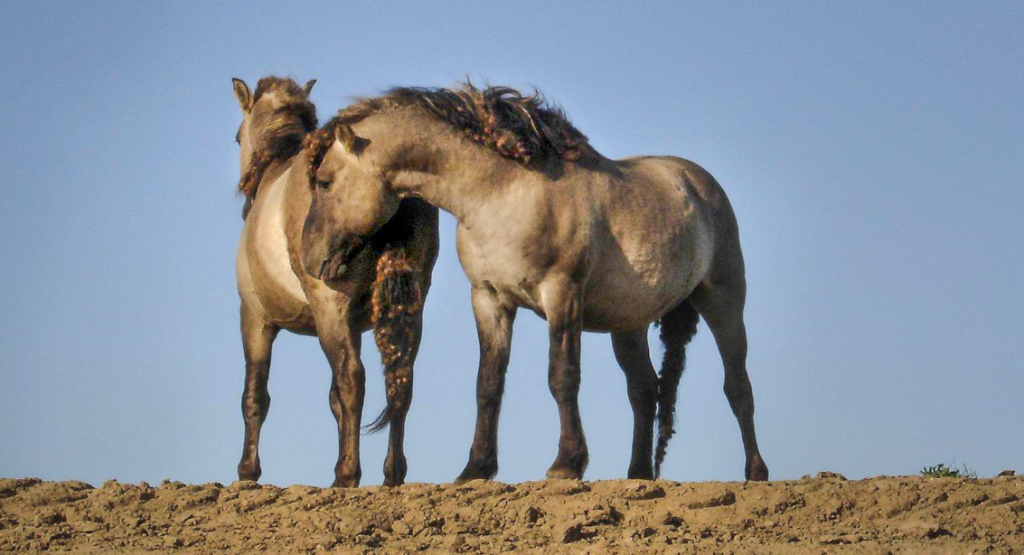
The Konik has been introduced into nature reserves in several countries all over the world. One of the first was ‘The Oostvaardersplassen’ in the Netherlands, my birth country. The Konik-herds help restore the original Dutch landscape characteristics through their grazing and migrating patterns. They also offer a perfect opportunity to study horse family-life and horse language. Because horses communicate very effectively! And what’s more, they all speak the same language, wherever they are! How cool is that?

Observing them is a fascinating experience that I got involved with when my sister was asked to contribute to a (Dutch) book about Koniks. She needed an extra pair of eyes to study them. I went out into the conservation areas with my camera and followed several family groups around for a couple of years, come rain or shine. It was an all-consuming activity that caused me sleepless nights because my head was filled with the images of the day. The film camera was simply too limited to store it all and I felt a great need to dump some of the images onto paper, with pastel crayons. I have always used art to express myself, but I was never so driven as with these horses. The largest part of my Konik-collection has now been sold and lives on walls in houses all over the world, but ‘Tricky’ has never been in an exhibit before because I did not want to let go of her. Still don’t. But she is available as an artprint… So what makes her so special?
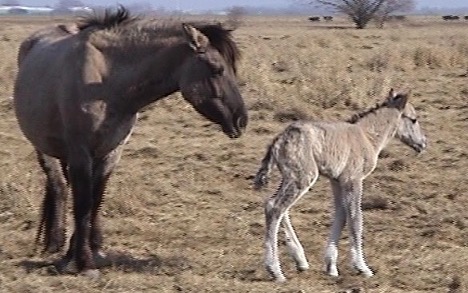
One icy cold morning in February 2003, I was following a family group and noticed a newborn. Her coat had just about dried, the birthing blood was still visible on her mother’s legs, so I guessed she had been around for only a couple of hours. She was the first baby of that season and she arrived early. She looked very fragile and skinny to me and I started filming her. The herd was at the edge of a natural pond that was largely frozen. At some point during my filming, the mare went over to the pond to have a drink of water at a spot that had clearly been used by the horses before. Of course, like all baby-horses, the filly followed her mother closely.
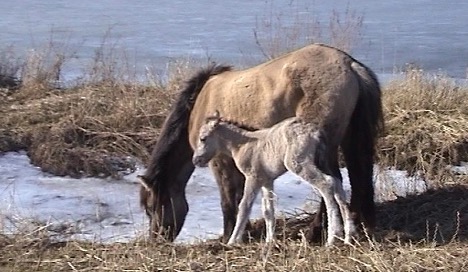
But disaster struck on the slope of the bank: the baby slipped and slithered onto the ice! I was horror-struck! I knew that part of the pond to be fairly shallow by human standards, but for a tiny little horse it could become a death trap! Initially, I watched and kept filming for a couple of minutes but when it became clear that Tricky’s meagre energy supplies were quickly fading, I decided to spring to the rescue. Her body heat was melting the ice and her whinnies became weaker and weaker. Her mother was observing it all, but knew instinctively that there was nothing she could do. The rest of the herd seemed to be unaware of what was going on. I knew about letting nature take its course and all that, but I also heard a determined voice in my heart say: “She is not going to drown on my watch!”.
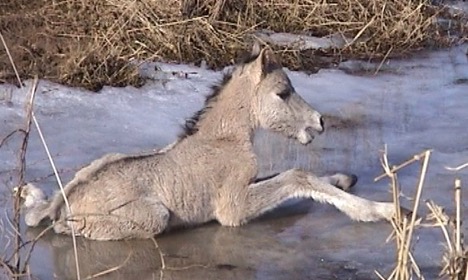
So there I was, the sole human in the company of 30 feral horses with an active lead mare and ditto stallion… were they going to let me approach the baby? I strongly believe that these animals knew about my good intentions, because they did. I looked at the stallion, I made eye contact with the mare… all seemed to be well. As I started towards the pond, the whole herd pricked up their ears and watched me.
My first move was to jump over the ice onto a small knoll of grasses behind the filly. I could stretch out and just hook my arms underneath her belly and pull her towards me. But then I realized my mistake: now the little horse and I were even further away from the herd that, by now, had all walked over to the bank to watch with great interest. There was only one way to go: I had to break the ice, step in and, with my arms still underneath the little horse’s belly, float her over to the other end. When we were at the slope of the opposite bank, I gave her a little shove to push her out of the icy cold water. The mother sniffed her foal and, before I was out of the pond myself, the entire family group started moving away from the pond. Away from danger!
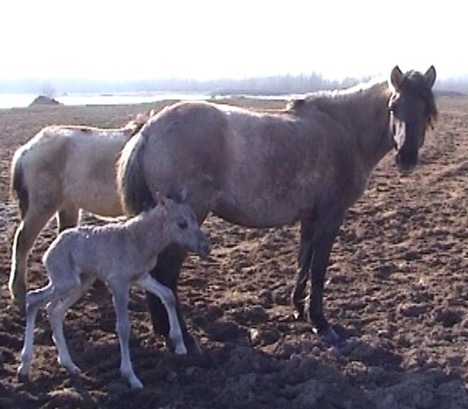
The water had come up half-way to my thighs, so by the time I picked up my camera-gear I was positively freezing. My heart sank when I looked over to the herd. The little filly was walking stiffly and stumbled from time to time over the frozen field. It did not look good and I was sure that she would not survive. I stood still to let the herd pass me and a most magical thing happened.
All other horses walked by single file without even giving me so much as a second look, but as the filly’s mother reached me, she stopped, demonstratively turned her head at me and looked me straight in the eye for a couple of seconds, as if to say: “Thank you!” and then started walking again. I was filming it all, and I rewound this scene several times to make sure I was not imagining things. It was both a wonderful and grueling experience.
I reported the incident to the conservation area’s manager, so he would know what had happened just in case he would stumble upon a dead filly. I did not want him to tell me about it, if he did. I did not really want to know the outcome.
But… two weeks later, I received an email. The manager told me that he had located “my” filly and that she was doing splendidly, very much alive and kicking and invited me to come over again to find and film her. So I did! It did not take me long to locate them. And there she was – clearly thriving, running around as if there was no tomorrow and with a good deal more flesh on her bones then the last time I saw her. I was so relieved!
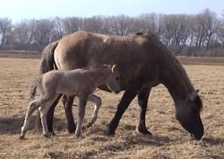
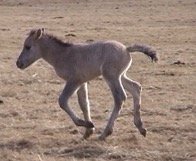
Although these horses are untouched by humans, they are monitored by the area managers to minimize inbreeding. Offspring are named after their mothers, with names that start with the first character of the mare’s name. The manager invited me to name this filly, as I had saved her life. I give you: Tricky, named after the situation she got herself into in the first hours after her birth; with a little wink to my own first name, Nicky!
